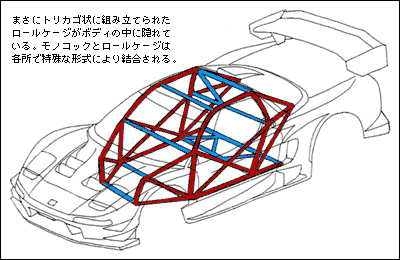This is an english translation of an original japanese article by Honda of Japan. The rights to this english translation belong to the Temple of VTEC Asia. All contents of this article are the intellectual property of Honda of Japan. Please refer to the main index page for further details.
| |

Learn of the Secrets Unseen From the Grandstands
Volume 5 - Its Bones Under the Skin
Lecturer: Akie Oku
*What is a Monocock Frame?
The past articles have covered the various aspects of the GT version NSX. This last article will concentrate on the underlying frame.
Humans aren't simply made of organs -- we have a skeletal structure. Likewise, a car has a basic skeletal structure which houses such things as the engine, suspension, etc. This basic skeletal structure is called a frame.
Automobile frames have a lot of variations. Some are literally built from a collection of pipes -- making it seem as if it were human-like. Most modern-day cars use a monocock-type frame. This is a frame that is made from layered plates -- looking more like an exoskeleton of a crab rather than an internal skeleton of a human. Some characteristics of the monocock frames include being light, and easily produced.
*Monocock + Rollcage
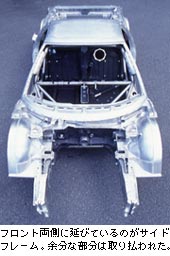 |
 |
An automobile monocock is typically made out of steel. However, the NSX's frame is made out of aluminum -- making it quite unique. While it is more difficult to process aluminum, it is lighter than steel. |
| The race side frame pierces through the monocock to the rear. Much more trimmed than the factory model. | ||
| The two arm-like things extending on the sides are the side frames. Extra panels were removed. |
An automobile monocock is typically made out of steel. However, the NSX's frame is made out of aluminum -- making it quite unique. While it is more difficult to process aluminum, it is lighter than steel.
On the two sides of the frame, there are two, pillar-like pieces called the sideframe. Much like the spine of a human, this is an important part -- however, under All-Japan GT Championship rules, these must be factory-issued and unmodified. Certain modifications to the ends to allow for different suspensions and larger tires are allowed. In order to optimize the chassis, virtually all of the chassis (other than the sideframe) were removed. Extra weight in the front and rear end of the vehicle greatly reduces mobility.
| Compare the factory frame with the GT frame. The GT frame is clearly more compact. However, in its current state, the GT frame has nowhere to connect the suspension, and is not strong enough to withstand the rigors of racing. Additional framework is added in strategic locations to augment the removed parts. A rollcage is installed inside of the chassis as well to ensure that the driver will be safe, even if a chassis-destroying crash were to happen. |  |
| The factory monocock frame. From here, excess is removed. |
*A Birdcage With Two Uses
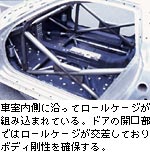 |
A rollcage is primarily installed for the safety of the driver, but it has ample strength to handle some of the stresses of racing on the chassis as well. In that sense, it acts as a support frame. Please see the illustrations. The highlighted area reflects the rollcage in the GT version NSX. As can be seen, the rollcage surrounds the cockpit area as if it is a birdcage. You'll also notice that the rollcage does not simply exist in the cockpit area, but extends into the engine compartment and the footwell. It's almost as if there is another frame within a frame.
|
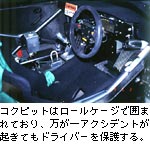 |
| The rollcage - note that the door area is reinforced with an x-shaped beam. | The cockpit is surrounded by the rollcage. |
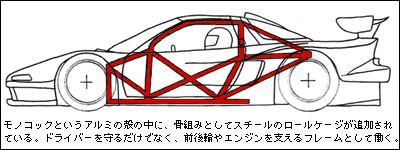 |
|
In addition to the basic aluminum
monocock, the rollcage is added. |
|
|
|
It's truly as if there is a
birdcage in there. The rollcage is, however, |
The brackets used to connect the suspension is typically made out of welding/melting steel. However, the GT version NSX's brackets are made out of high-rigidity aluminum ingots. The
ingots were ordered, and the brackets were carved out by skilled technicians. This tedious process took one month for every pair of brackets made. These brackets were attached to the ends of the side frame, and the rollcage provided additional support. The rollcage also supports the engine mount, too. Please reference the illustrations and compare them to the photos of the just-finished GT version NSX's chassis. You should be able to see the piping inside the cockpit, and how the rollcage extends beyond the cockpit.
*Connecting Aluminum and Steel
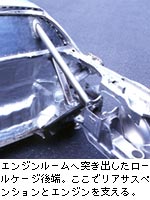
|
As can be seen, the GT version NSX utilizes a rollcage and an all-aluminum chassis. As a race car, this is nothing unique. However, since the All-Japan GT Championship rules mandated that the rollcage be made of steel, we were faced with the task of having to weld aluminum and steel together. Because of their different properties, it is not possible to directly weld aluminum to steel. |
| The rollcage sticks out to the engine room, where it gets connected to the suspension and engine. |
After many trials, the resolution was to attach a steel plate to the steel rollcage, and attach an aluminum plate to the aluminum frame -- and connect them with glue and rivets. It is a rather unique process, as you may have guessed. To augment this unique attachment, 2mm of carbon fibre were added to the chassis surface, and in key points such as the footwell, a carbon fibre overlay was applied to provide a more secure attachment. If you look at the photos, you should be able to see the area where the rollcage and chassis meet covered with carbon fibre.
*The New And Improved Frame...is Heavier?
One of the struggles of a race car is that of weight. So, what has become of the weight of this new and improved frame for the GT version NSX? The factory frame is 170kg, which is very lightweight for a factory car. The unnecessary parts were removed, reducing the weight to 150kg. The rollcage is 110kg, and when added to the frame with the additional carbon fibre support, the chassis weight is a grand total of 350kg.
Let's review that again -- the factory chassis is 170kg, and the race chassis is 350kg -- more than twice the weight. At face value, any person would be wondering, 'I thought racing was all about reducing the weight by shaving off grams here and there?' As it turns out, the All-Japan GT Championship mandates a minimum weight of 1150kg. When one considers this, we can't simply make a car that is light, and lacks the structural integrity a race car requires. Instead, it's more important to think of how weight can be distributed in/on the chassis.
The NSX already started with a light chassis, so this allowed us to make many modifications to distribute the weight proportionately. Matter of fact, the 350kg chassis is still too light, and the GT version NSX has to install deadweights to reach the minimum weight limit.
![]()
Hopefully you enjoyed the last 5 volumes of articles written. Some of it may have been difficult for beginners, but hopefully you got a taste of the challenges and the enjoyment that is involved in making a race car out of a factory car. Honda will participate in the 2000 championships as well, so hopefully you can keep these articles in mind as you watch the championship series. Until we meet again...
| INDEX | ||
| BACK |
Updated February 15, 2000
